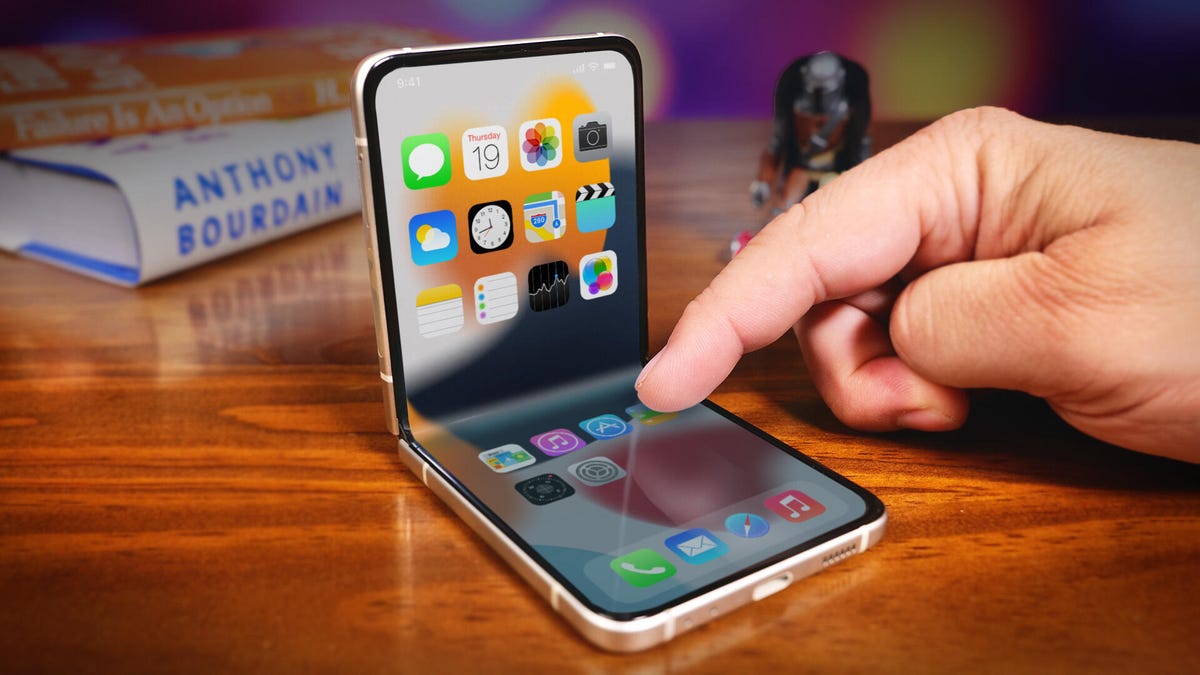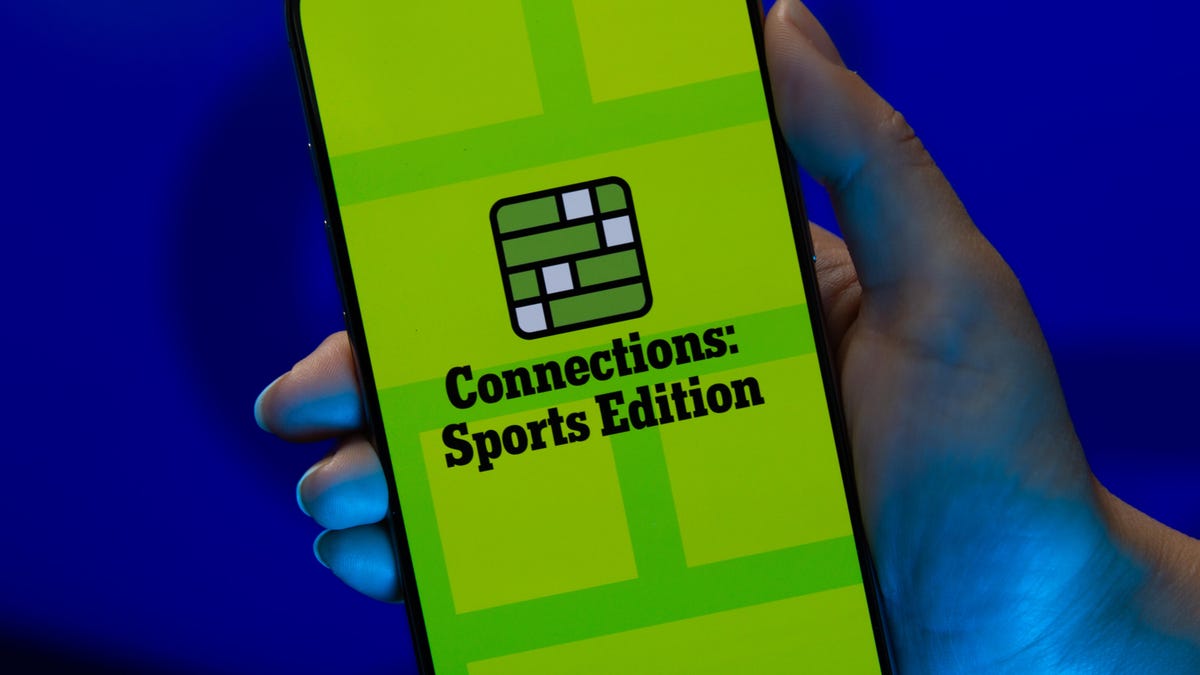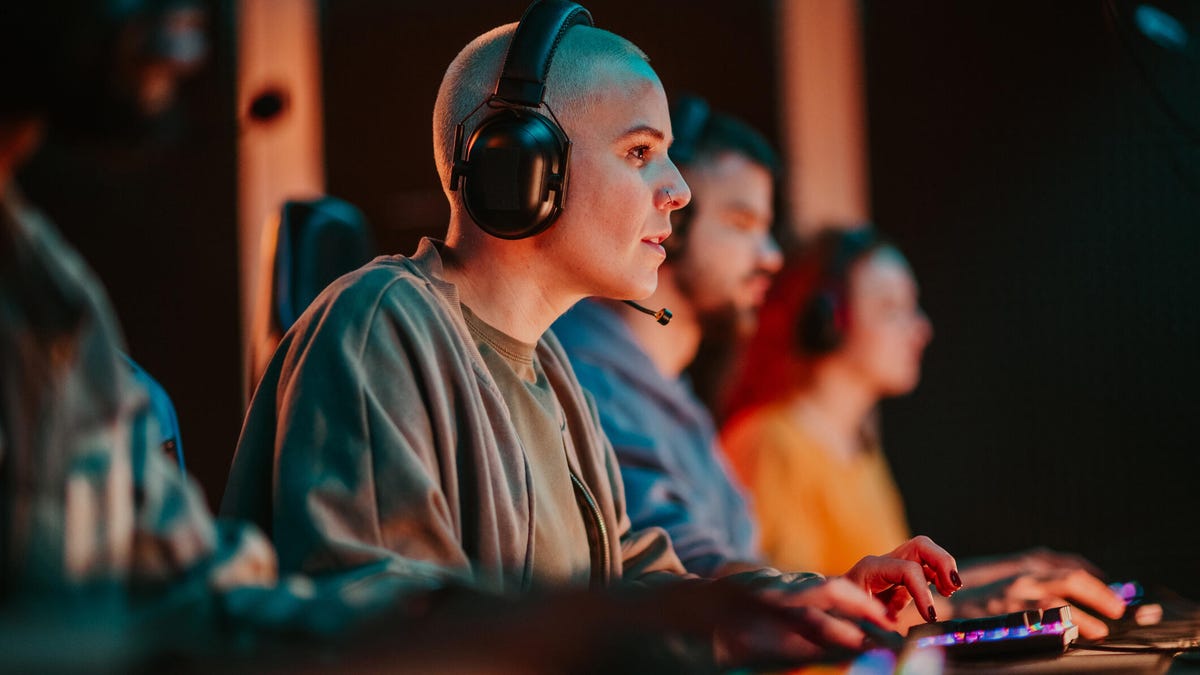Technologies
Why Apple Hasn’t Released the iPhone Fold… Yet
Commentary: Apple debuted the iPhone 14 Pro in September, but a foldable iPhone still feels like a longshot.

This story is part of Focal Point iPhone 2022, CNET’s collection of news, tips and advice around Apple’s most popular product.
Apple’s new iPhone 14 line includes some of the biggest hardware updates made in years, including the iPhone 14 Pro’s redesigned cutout for Dynamic Island’s contextual notifications and an iPhone 14 Plus model. But among the changes, Apple has not yet confirmed if a rumored foldable iPhone is in development. This is particularly curious as Samsung continues to refine its foldable phone lineup with the release of the Galaxy Z Flip 4 and the Galaxy Z Fold 4 back in August.
Samsung isn’t the only company making phones with foldable screens. There’s the Motorola Razr. And outside the US, Huawei and Xiaomi also have foldable phones. Which leaves us with an obvious question: Where’s Apple’s foldable iPhone?
Apple doesn’t comment on future products
The first thing to consider is that Apple doesn’t announce products until they’re ready. OK, there was the AirPower wireless charging pad. But otherwise Apple isn’t going to tell us it’s working on a foldable iPhone or confirm rumors.
Next, Apple typically positions products as a solution to a problem, highlighting quality and innovation.
The Galaxy Z Fold seems less like an answer to a problem and more of a «look at this tech wizardry, what can we do with it?!» And the cool-factor, as ingenious as it is, comes at the expense of features we expect from regular phones, including battery life, ergonomics, software experience and price. The Galaxy Z Flip solves the problem of portability, but it comes with some of the same drawbacks as the Fold, particularly around battery life and camera quality.
To be fair, the Galaxy Z Fold 3 took a significant step forward by embracing its large main screen and adding support for Samsung’s S Pen stylus. And the Z Fold 4’s improved Flex Mode for apps seems like it might tip the balance, making the Fold more useful than just cool.
If Apple were to release a foldable iPhone, what problem would it solve? Could it be an iPhone Flip, replacing the iPhone 13 Mini by offering you a big screen that’s still pocket-friendly? Or will it be an iPhone Fold — more like an iPad Mini that folds in half, making its closed size more like the iPhone 13 Pro Max? Or will we see a design that doesn’t exist yet? What about an iPhone Roll, where the screen unrolls like an expanding window shade? That’s where rumors start to enter the picture.
iPhone Fold rumors
Back in January 2021, Mark Gurman wrote for Bloomberg that Apple «has begun early work on an iPhone with a foldable screen, a potential rival to similar devices from Samsung.»
And in May of 2021, analyst Ming-Chi Kuo said, as reported by MacRumors, that «Apple will likely launch a foldable iPhone with an 8-inch QHD Plus flexible OLED display in 2023.» He revised his prediction, in a tweet this past April, to say that it might be 2025 before there’s a foldable screen device from Apple. It’s also worth noting that Kuo’s tweet was on April 1, which means it could have been an April Fool’s joke.
Both Gurman and Kuo have excellent track records when it comes to Apple rumors. So if these reports are accurate, we’ll see a foldable iPhone in 2025. It will be about the size of an iPad Mini and it’ll fold in half. End of story. But hold on.
How to make a foldable iPhone
Before Apple makes a foldable iPhone, it has to figure out how to make a foldable iPhone. Research company Omdia claims that in 2021, 11.5 million foldable phones shipped. Apple sells hundreds of millions of iPhones a year. So if it makes a foldable iPhone, it has to be certain that it can manufacture the phones at the same quality and in a high enough quantity to meet demand. More times than not when Apple introduces a radical hardware change — like 2014’s iPhone 6 Plus and its larger screen — those models are hard to find at launch because they sell out quickly. Sometimes they’re given a later release date, as we saw with the iPhone 12 Mini and 12 Pro Max launch.
Then there’s the physical complexity that needs to be considered. Foldable phones have numerous mechanical parts that could malfunction or wear, such as hinge components that keep dust out and the various layers behind the folding screen. In fact, when journalists tested review units of the original Galaxy Fold, the device was plagued by hinge and display failures. That was years ago, of course, and Samsung has since fixed those issues. But it shows what can happen with first-gen products.
If a foldable iPhone is in the works, Apple will likely innovate its design to minimize the parts and mechanisms involved, which should reduce the possibility of the phones failing because something breaks. The Cupertino company has a great track record in this area.
When Apple released the iPhone 7, it replaced the home button with a faux home button so there was one less mechanical part that could possibly break. And if you’ve ever owned or used a MacBook, you know Apple is at the top of its game when it comes to hinge design, and dependability. Apple also sells AppleCare Plus service — and includes a global infrastructure to support it — which could help relieve concerns over problems or accidental damage, should it release a foldable phone.
iOS and iPadOS would need to be revamped
And then there’s the software. One UI, Samsung’s name for its take on Android, has to be the most under-appreciated aspect of the Galaxy Z Flip and Z Fold. These new designs would have to simultaneously do all the things we expect from current phones while also creating new functionality that takes advantage of their folding screens. They’d also have to do all of these things flawlessly without any bugs or hiccups.
For instance, the Galaxy phones’ Flex Mode has been around for years. Essentially, when the Fold or Flip are folded into an L-shape, like a mini laptop, the software shifts an app to the top half of the screen while providing functionality at the bottom. Sounds cool and full of possibilities, right?
Well, until this year that functionality has been limited. That’s why it matters that Samsung’s Z Flip 4 and Z Fold 4 let you turn the bottom half of their screens into touchpads while they’re in Flex Mode. The company is now showing an added benefit of the fold.
I’d like to see even more software optimized for foldable phones. And I expect Apple will face the same challenges as Samsung did, especially when adapting iOS and iPadOS.
In recent years, iOS and iPadOS have drifted apart as Apple has created more iPad-specific features that wouldn’t make sense on an iPhone. A foldable iPhone, especially in the style of a Galaxy Z Fold 4, would require a reunion of the two operating systems. Or, Apple would have to develop a new software platform that can morph between a tablet and phone mode.
Apple would likely develop a unique software feature (think iMessage or Portrait Mode) to help make its foldable phone standout from what everyone else is doing.
How much would you pay for a foldable iPhone?
Foldable phones ain’t cheap. The Galaxy Z Fold 4 starts at $1,800 and the Galaxy Z Flip 4 at $1,000. And it’s no surprise that prices for Apple products are at the higher end. So if an iPhone 14 Pro that doesn’t fold in half already costs $1,000, what would be the price for one that does?
For a foldable iPhone to be successful, Apple would need to create a problem-solving design, scale manufacturing without sacrificing quality and develop hardware along with software that make the most of its foldable build. The price would also have to be premium, but not too high.
So where’s the foldable iPhone? Still in the oven.
Technologies
If You Were ‘Tricked’ Into an Amazon Prime Subscription, You Should Have Been Paid by Today
Amazon is paying $1.5 billion to people who mistakenly subscribed to Prime, and the first round of payments are due today.

Amazon Prime provides a lot of valuable benefits to its members, but the company’s registration practices for its premium subscription from 2019 to 2025 led to many customers accidentally subscribing to a service they didn’t want.
Amazon is now paying the price for that deception — the US Federal Trade Commission levied a massive $2.5 billion settlement on the company for its subscription tactics.
The majority of the settlement — $1.5 billion — has been earmarked to refund eligible subscribers, with the rest serving as a civil penalty. Amazon is also now legally required to provide a clear, obvious option to decline Prime, making it as easy to leave the service as it is to join.
Amazon isn’t admitting to shady behavior. «Amazon and our executives have always followed the law, and this settlement allows us to move forward and focus on innovating for customers,» Mark Blafkin, Amazon senior manager, said in a statement. «We work incredibly hard to make it clear and simple for customers to both sign up or cancel their Prime membership, and to offer substantial value for our many millions of loyal Prime members around the world.»
The online retail giant started sending out payments to eligible people in November and was supposed to conclude its initial automatic payments today, Dec. 24. Read on to learn more about Amazon’s settlement and what to do if you think you’re eligible for compensation but didn’t receive a payment.
Why did the FTC fine Amazon?
The FTC filed suit against Amazon, accusing the company of using «dark patterns» to nudge people into Prime subscriptions and then making it too hard to cancel. The FTC maintained Amazon was in violation of Section 5 of the FTC Act and the Restore Online Shoppers’ Confidence Act.
«Specifically, Amazon used manipulative, coercive or deceptive user-interface designs known as ‘dark patterns’ to trick consumers into enrolling in automatically renewing Prime subscriptions,» the FTC complaint stated.
Who’s eligible for Amazon’s payout?
Amazon’s legal settlement is limited to customers who enrolled in Amazon Prime between June 23, 2019, and June 23, 2025. It’s also restricted to customers who subscribed to Prime using a «challenged enrollment flow» or who enrolled in Prime through any method but were unsuccessful in canceling their memberships.
The FTC called out specific enrollment pages, including Prime Video enrollment, the Universal Prime Decision page, the Shipping Option Select page and the Single Page Checkout. To qualify for a payout, claimants must also not have used more than 10 Amazon Prime benefits in any 12-month period.
Customers who signed up via those challenged processes and did not use more than three Prime benefits within one year will be paid automatically by Amazon within 90 days. Other eligible Amazon customers will need to file a claim, and Amazon is required to send notices to those people within 30 days of making its automatic payments.
If you are eligible for the automatic payment, you should have received an email from Amazon by today explaining how to claim the money. You can be paid via PayPal or Venmo. If you prefer a paper check, don’t accept the digital payment. The FTC says Amazon will mail you a check that you must cash within 60 days.
How big will the Amazon payments be?
Payouts to eligible Amazon claimants will be limited to a maximum of $51. That amount could be reduced depending on the number of Amazon Prime benefits you used while subscribed to the service. Those benefits include free two-day shipping, watching shows or movies on Prime Video or Whole Foods grocery discounts.
Customers who qualify for the payments should have received them from Nov. 12 to Dec. 24, 2025.If you are eligible for compensation from Amazon but didn’t receive a payout, you’ll need to file a claim after Amazon starts the claim process. The FTC says it will update its Amazon settlement site once that process has begun.
Customers who did not use a challenged sign-up process but instead were unable to cancel their Prime memberships will also need to file claims for payment.
Technologies
Today’s NYT Connections: Sports Edition Hints and Answers for Dec. 25, #458
Here are hints and the answers for the NYT Connections: Sports Edition puzzle for Dec. 25, No. 458.

Looking for the most recent regular Connections answers? Click here for today’s Connections hints, as well as our daily answers and hints for The New York Times Mini Crossword, Wordle and Strands puzzles.
Today’s Connections: Sports Edition has a real mix of categories, including one that’s all about a certain famous athlete. If you’re struggling with today’s puzzle but still want to solve it, read on for hints and the answers.
Connections: Sports Edition is published by The Athletic, the subscription-based sports journalism site owned by The Times. It doesn’t appear in the NYT Games app, but it does in The Athletic’s app. Or you can play it for free online.
Read more: NYT Connections: Sports Edition Puzzle Comes Out of Beta
Hints for today’s Connections: Sports Edition groups
Here are four hints for the groupings in today’s Connections: Sports Edition puzzle, ranked from the easiest yellow group to the tough (and sometimes bizarre) purple group.
Yellow group hint: Swing away!
Green group hint: What’s that on your bat?
Blue group hint: Catch the football.
Purple group hint: Lake Placid or Lillehammer.
Answers for today’s Connections: Sports Edition groups
Yellow group: Baseball bat materials.
Green group: Associated with George Brett.
Blue group: NFL rookie WRs.
Purple group: Olympic ____.
Read more: Wordle Cheat Sheet: Here Are the Most Popular Letters Used in English Words
What are today’s Connections: Sports Edition answers?
The yellow words in today’s Connections
The theme is baseball bat materials. The four answers are aluminum, ash, birch and maple.
The green words in today’s Connections
The theme is associated with George Brett. The four answers are 5, pine tar, Royals and third base.
The blue words in today’s Connections
The theme is NFL rookie WRs. The four answers are Burden, Egbuka, Golden and McMillan.
The purple words in today’s Connections
The theme is Olympic ____. The four answers are Games, rings, torch and village.
Don’t miss any of our unbiased tech content and lab-based reviews. Add CNET as a preferred Google source.
Technologies
Christmas Eve Gaming Crushed as Steam Goes Offline
Services related to the popular game hub seem to slowly be returning as of Wednesday afternoon.

Your Christmas Eve gaming session might not go as planned. Online gaming hub Steam went down on Wednesday. As of about 1:30 pm PT, the Steam store page was once again accessible, so services seemed to be coming back online.
The Steam outage appeared to begin mid-afternoon ET, according to Downdetector, which monitors site outages. (Disclosure: Downdetector is owned by the same parent company as CNET, Ziff Davis.)
A representative for Steam did not immediately respond to a request for comment.
As of Wednesday noon PT, Steam’s official X and Bluesky accounts hadn’t posted anything about the outage.
Gamers certainly noticed. «Steam down, Steam down!!!» wrote one Bluesky user.
Others commented on the bad timing just as gamers were enjoying time off or receiving gaming gifts. «‘You got a gift on Steam!’ oh cool ‘Steam is down’ oh cool,» wrote another Bluesky user.
-

 Technologies3 года ago
Technologies3 года agoTech Companies Need to Be Held Accountable for Security, Experts Say
-

 Technologies3 года ago
Technologies3 года agoBest Handheld Game Console in 2023
-

 Technologies3 года ago
Technologies3 года agoTighten Up Your VR Game With the Best Head Straps for Quest 2
-

 Technologies4 года ago
Technologies4 года agoBlack Friday 2021: The best deals on TVs, headphones, kitchenware, and more
-

 Technologies4 года ago
Technologies4 года agoVerum, Wickr and Threema: next generation secured messengers
-

 Technologies4 года ago
Technologies4 года agoGoogle to require vaccinations as Silicon Valley rethinks return-to-office policies
-

 Technologies4 года ago
Technologies4 года agoOlivia Harlan Dekker for Verum Messenger
-

 Technologies4 года ago
Technologies4 года agoiPhone 13 event: How to watch Apple’s big announcement tomorrow
